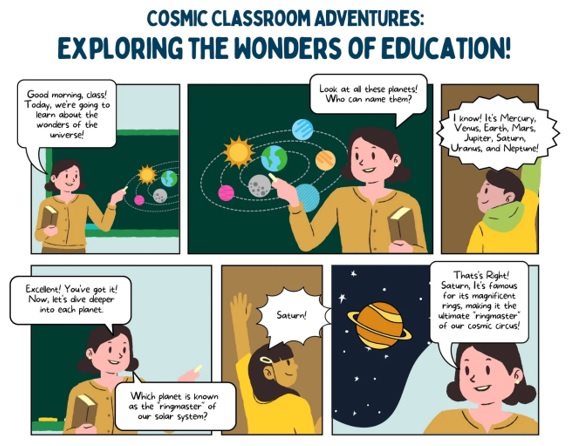Why Comic Strips Make Great Assessment Tools?
8th November 2024

Who would've thought that one of the most captivating ways to assess student learning could be through comic strips? Yes, you heard it right!
Imagine your young learners, each with a unique level of English proficiency, stepping into the shoes of ocean superheroes to tackle plastic pollution. The task was energizing, allowing students to express their grasp of environmental issues creatively through vivid illustrations and storytelling. Tools like vision boards helped map their thoughts into six-box comic adventures, culminating in a gallery walk for peer assessment.
The journey of using comic strips didn't end there! It opened doors to evaluating various subjects, from environmental science to language learning by visually capturing concepts like the growth of a seed or exploring emotive adjectives. This method turns otherwise stressful assessments into a joyful, artistic expression of knowledge. Those teachers who have pursued courses like online pre primary teacher training course, knows it really well.
If you also want to know more about this interesting, fun and engaging assessment method, then we have got you covered.
In this blog post, we will explore more about how using comic strips as an assessment tool can be a game changer in your classroom!
Benefits of Comic Strips in Education
Before getting to know how you use comic strips as an assessment tools, let’s get to explore some of the benefits first:
- Enhancing Student Engagement
Comic strips are an energetic way to magnetize student interest and participation! The simple act of crafting a story through colorful visuals and dialogue bubbles transforms otherwise tedious topics into exciting adventures.
When students have the freedom to put their thoughts into characters and action, they become active participants in their own learning journey. This approach not only caters to diverse learning styles but also makes classroom activities thrilling and memorable. Imagine the engagement levels soaring as students eagerly showcase their unique stories to their classmates!
- Supporting Language Learning
For language learners, comic strips provide a visual feast that simplifies complex linguistic concepts. By presenting vocabulary and grammar in context, they become more relatable and easier to comprehend. Students can see how language functions in real-life scenarios, making learning feel less abstract.
They get to experiment with new phrases and vocabulary within their storytelling, which anchors their understanding and boosts their communication skills. Aren’t comic strips just the perfect catalyst to kick language anxiety to the curb?
- Encouraging Creative Expression
Creativity is liberating, and comic strips offer a blank canvas for students to unleash their imagination. Whether they are drawing detailed scenes or scripting witty dialogues, students are encouraged to express themselves without boundaries.
This nurturing of creativity not only enhances their critical thinking skills but also fosters self-confidence and individualism. There’s no right or wrong in artistic expression, and that’s exactly what makes this tool a winner in motivating learners to think outside the box and shine through their art.
Before you move to the topic, can we ask you a quick question? Do you follow us on Social Media? If not, then you’re missing out on a lot of informative content. We regularly share upgraded educational content, tips, feedback, and more. Check us out by clicking the profiles here - Facebook / Twitter / LinkedIn / Pinterest / Instagram / YouTube
Implementation Steps for Comic Strip Assessments
Let’s get to know step by step implementation tips for comic strips as an assessment tools:
- Scaffolding Activities to Prepare Students
Preparation is key when introducing comic strips as an assessment tool. Start by integrating engaging activities such as lifespan-of-plastic matching games or educational videos to build a foundation for the main project. Discussions and storytelling exercises can further help students get comfortable with concepts they might use in their comics.
By using scaffolding activities, educators can gradually introduce students to the task without overwhelming them, thus ensuring a solid understanding before they dive into creating their masterpieces!
- Criteria for Comic Strip Assignments
Setting clear criteria is crucial for guiding students in their comic creation. Encourage them to incorporate specific themes or vocabulary - for instance, using words like "reduce," "reuse," and "recycle" when exploring environmental topics.
Descriptive imagery and cohesive storytelling should be emphasized, ensuring that actions taken by characters align with the lesson's objectives. Providing students with a structured yet flexible framework allows them to navigate their creativity within defined boundaries, leading to a purposeful and educational comic strip project.
- Vision Boards and Focus Maintenance
Vision boards are a great tool to help students visualize their story’s progression and keep track of essential story elements. Encourage learners to map out their ideas and organize the narrative flow from start to finish. This visual planning phase empowers students to focus on their storytelling goals while aligning with the lesson's objectives.
With vision boards, students gain clarity and stay on course, ensuring their artistic expressions remain both creative and educationally relevant. This structured yet creative approach is bound to make their comic journey a success!
Assessment Techniques for Comic Strips
Let’s get to know some of the fun and engaging assessment techniques
- One-on-One Oral Assessments
Imagine sitting down with each of your students and having a delightful conversation about their comic strip creations. One-on-one oral assessments offer an intimate opportunity for teachers to dive into the thought processes of their students. In this approach, the educator engages directly with the students, discussing their comic's story, examining their vocabulary choices, and evaluating their understanding of specific concepts.
This method not only allows teachers to assess students’ grasp of the subject matter but also encourages students to express their ideas verbally, fostering communication skills. The personal interaction creates a supportive environment where students can openly discuss their work, making the assessment process less intimidating and much more fun!
- Peer Feedback Through Gallery Assessments
Peer feedback is a powerful tool, and gallery assessments take this to a whole new level! Imagine a classroom transformed into an art gallery where students proudly display their comic strips for everyone to see. As students wander around, they're encouraged to provide constructive feedback on each other's work.
This collaborative assessment technique inspires students to think critically and creatively about the comics created by their peers. By reviewing and discussing each other's work, students learn to value different perspectives and develop a deeper understanding of the subject matter.
Varieties of Comic Strip Formats
Let’s get to know different varieties of comic strip formats:
- Traditional Printable Templates
Traditional comic strip templates are like a playground for creativity! Several websites offer free downloadable templates that invite students to grab their pencils and let their imaginations run wild. These printables come in different sizes and styles, allowing students to choose the format that best suits their story.
Printable comic strips are not only easy to use but also serve as an excellent starting point for younger students or those who might be hesitant to dive into the digital world. The tactile experience of drawing by hand can engage students in a unique way, offering a refreshing break from screens.
- Digital Creation with Canva

Source: canva.com
For those tech-savvy learners, digital creation tools like Canva unlock endless possibilities! With Canva, students can use pre-designed comic strip templates or even create their own from scratch using an assortment of graphics and photos. This digital platform provides an exciting, user-friendly interface that enables students to experiment with various design elements.
Canva is especially useful for students who might feel less confident in their drawing skills, as it offers a plethora of graphics to bring their stories to life. The digital format also allows for easy sharing and collaboration, making it perfect for group projects or remote learning environments.
Interdisciplinary Uses of Comic Strip Assessments
Comic strips aren't just for laughs! They can bridge various subjects, offering a creative blend of art and education. This interdisciplinary approach excites students and breathes life into their learning experience. Let's dive into how comic strips can make learning a fun-filled journey across different subjects!
- Environmental Science: Life Cycle Projects
In environmental science, comic strips can vividly portray concepts like life cycles and environmental conservation. For instance, students can craft a six-panel comic strip illustrated with the life cycle of a plant, from the tiny seed to the grand flower!
This activity encourages students to visualize each stage of growth creatively. They integrate both textual descriptions and vivid drawings, showcasing their understanding of the process through a narrative. The creativity embedded in developing these comics enhances student engagement and helps solidify complex concepts through vivid storytelling.
- ESL Activities: Exploring Emotions
Turning to ESL (English as a Second Language) learning, comic strips become invaluable in helping students explore and express emotions creatively. Imagine students delving into adjectives like "happy," "sad," "excited," and "frustrated"!
They're tasked with developing short comic strips that incorporate these words into a storyline. Such tasks not only aid vocabulary and sentence structure comprehension but also allow students to depict emotions visually, turning learning into an expressive art form. The results are often delightful and deeply personal, rendering the language-learning process both impactful and joyful.
Redefining Assessment Through Creativity
Comic strips are not just about adding a splash of art to the classroom; they are about redefining assessment strategies with a creative twist. By weaving storytelling with visual skills, teachers unlock new ways for students to express and demonstrate their understanding. This innovative approach transforms the traditional notion of assessment from a source of stress into an exciting, engaging process.
- Student Empowerment: Through comic strips, students gain the opportunity to articulate complex ideas using both language and imagery, cultivating not just knowledge but also confidence in their creative abilities.
- Diverse Learning Styles: By catering to various learning styles, comic strips ensure that every child, regardless of their preferred mode of learning, finds a voice and a platform to shine.
- Cross-Disciplinary Potential: From environmental science to emotional literacy, the versatility of comic strips allows educators to apply them across subjects, bridging gaps between disciplines and making learning a colorful journey.
So, let’s embrace comic strips as an exciting teaching strategy, enabling a richer, more dynamic educational experience! If you want to learn more latest and engaging teaching strategies, then consider pursuing courses like online pre-primary teacher training course, where you will get to learn from top expert trainers.
We believe education should be accessible for everyone. That’s why we don’t charge for our blogs. Find the right course that will help you in your career with us, contact us at - 1800–212–6400. You can mail us at act@asiancollegeofteachers.com.
Written By : Abhishek











